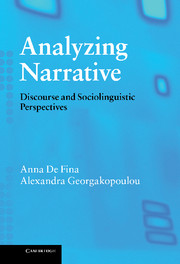Book contents
- Frontmatter
- Contents
- Acknowledgments
- Preface
- Note on transcription conventions
- 1 Narrative definitions, issues and approaches
- 2 Narrative as text and structure
- 3 Narrative and sociocultural variability
- 4 Narrative as interaction
- 5 Narrative power, authority and ownership
- 6 Narrative and identities
- Notes
- References
- Index
1 - Narrative definitions, issues and approaches
Published online by Cambridge University Press: 05 June 2012
- Frontmatter
- Contents
- Acknowledgments
- Preface
- Note on transcription conventions
- 1 Narrative definitions, issues and approaches
- 2 Narrative as text and structure
- 3 Narrative and sociocultural variability
- 4 Narrative as interaction
- 5 Narrative power, authority and ownership
- 6 Narrative and identities
- Notes
- References
- Index
Summary
Introduction
More than numerous objects of inquiry, narrative resists straightforward and agreed-upon definitions and conceptualizations. Instead, its study tends to be a minefield of multiple and at times competing perspectives in a wide array of humanities and social science fields. This is a sign of richness and refreshing pluralism for some, while a sign of deplorable fragmentation for others; but the fact remains that any attempt to present and pull together different strands in the area involves delicate issues of selection and representation. It is with this acute awareness that an exhaustive and evenly balanced overview is close to impossible that we will approach in this chapter the complicated yet fundamental issues of “What is narrative?” and “How is it studied?” That said, two principles have guided our selection of materials in the discussion to follow:
The inclusion of approaches that in more or less explicit ways have influenced the assumptions and tools of what will form the main focus of this book, namely socially minded linguistic approaches to narrative.
The need to extract and bring to the fore aspects of convergence and even overlapping interests from traditions that on the face of it may have developed separately.
In this attempt to pull threads together, we have seen it fit to pose a working distinction, by no means dichotomous, between views of narrative as a type of text and views of narrative as a mode, epistemology and method. We will thus map each of the poles of this distinction with specific approaches and what we see as distinct assumptions and ways of analyzing narrative in them.
- Type
- Chapter
- Information
- Analyzing NarrativeDiscourse and Sociolinguistic Perspectives, pp. 1 - 25Publisher: Cambridge University PressPrint publication year: 2011



